Blog
15 Interesting Facts About Rio de Janeiro
- Thursday February 4th, 2021
- Posted by: Amanda Ennes
- Category: Rio de Janeiro
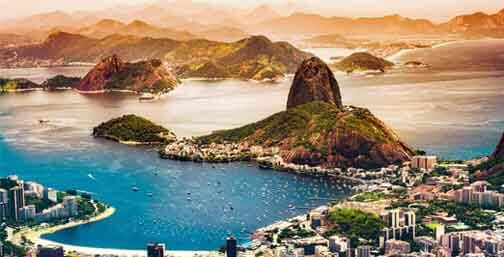
Rio is known all over the world as the wonderful city, ‘A Cidade Maravilhosa’. But if you think the beaches and samba are all Rio has to offer, think twice. There are many interesting facts about Rio de Janeiro to discover still.
Rio is a vibrant and gorgeous city, where everyone comes together and live in harmony. Nature is exquisite. People are nice and fun. The beaches are amazing! The city is full of culture, history, colors, sounds, animals…
Take a look at this post and learn 15 amazing facts about Rio de Janeiro. By the end of your reading, you will love Rio even more!
Table of Contents
ToggleRiver of January
Rio de Janeiro is named after a river that doesn’t even exist. Yes, you heard it correctly! The Portuguese first came to Rio de Janeiro in January 1502. By then, they thought the Guanabara Bay was a river mouth. Hence, they named the city Rio de Janeiro (River of January, in English).
Capital of Portugal
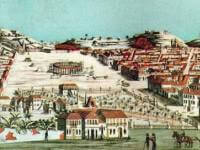 In the midst of a war against France, the Portuguese crown decided to run away to Brazil in the nineteenth century.
In the midst of a war against France, the Portuguese crown decided to run away to Brazil in the nineteenth century.
As a result, the royal family and over 15,000 people arrived in Rio de Janeiro in 1808. They brought their furniture, art, jewelry, books, files, and all the royal treasures with them. And so, the Portuguese crown founded the new capital of Portugal.
Until then, Rio de Janeiro was just a small village. Therefore, it had to expand rapidly, starting an urbanization process that moved towards São Cristóvão, Flamengo, Botafogo, and Laranjeiras neighborhoods.
French Invasion
In the mid-seventeenth century, France invaded Rio de Janeiro. They built a fort and decided to found France Antarctique, a French colony in Brazil. Of course, the king of Portugal was not happy with the news. He sent the new Governor-General of Brazil, Mem de Sá, to expel the French from Brazilian lands.
With this in mind, the Portuguese sought help from the head of the Temiminos indigenous tribe, Araribóia. Because they knew the area very well, the whole tribe helped the Portuguese crown to defeat the French invasion.
In order to reward Araribóia and seeking for more protection to the entrance of the Guanabara Bay, the Portuguese government gave him a gift: a piece of land on the other side of the bay. This area corresponded to what is nowadays the city of Niterói. Niterói means Hidden Waters in Tupi language.
Baía de Guanabara
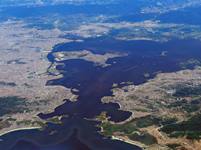 The cities of Rio de Janeiro, Duque de Caxias, Niterói, São Gonçalo, Magé, Guapimirim, and Itaboraí lie on the shore of the Guanabara Bay. The Rio-Niterói bridge, crossing the bay, is the 48th longest in the world, measuring 13.29 km in lenght.
The cities of Rio de Janeiro, Duque de Caxias, Niterói, São Gonçalo, Magé, Guapimirim, and Itaboraí lie on the shore of the Guanabara Bay. The Rio-Niterói bridge, crossing the bay, is the 48th longest in the world, measuring 13.29 km in lenght.
Unfortunately, the Guanabara Bay is heavily polluted. The sewage system in Rio de Janeiro only treats 40% of the total sewage produced around the Bay.
There are over 100 islands within the Guanabara Bay. There are large ones, such as Ilha do Governador, and tiny little ones.
Christ The Redeemer Statue
The Christ the Redeemer statue has become emblematic of both the city of Rio de Janeiro and the whole nation of Brazil.
Brazilian engineer Heitor da Silva Costa and French-Polish sculptor Paul Landowski began building the statue in 1926. They completed the project in 1931. The statue stands 98 feet (30 meters) tall, with its horizontally outstretched arms spanning 92 feet (28 meters).
In 2007, Swiss-based organization The New Open World Corporation recognized the Christ the Redeemer statue as one of the New Seven Wonders of the World.
Sugarloaf Cable Car
Opened in 1912, the Sugarloaf Cable Car was only the third cableway to be built in the world.
Footvolley
 Footvolley is a sport invented by Octavio de Moraes in Copacabana Beach during the ’60s. It is a mix of beach volleyball and football.
Footvolley is a sport invented by Octavio de Moraes in Copacabana Beach during the ’60s. It is a mix of beach volleyball and football.
The game is played with 2 players on each side of the court. Footvolley essentially follows the same rules of beach volleyball, but you cannot use your hands to touch the ball. You should only use your feet, chest, and head.
Neighborhoods
The city of Rio de Janeiro is divided into 33 administrative regions and 162 neighborhoods. The most densely populated ones are Campo Grande, Bangu, Santa Cruz, Realengo, and Tijuca, respectively. Campo Grande alone has 328,370 inhabitants.
Olympic Games
Rio de Janeiro has hosted the 2016 Summer Olympics. Because of that, Rio became the first South-American city to ever hold the games.
Beaches
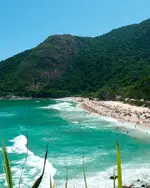 According to TripAdvisor’s 2020 Traveller’s Choice Awards, the state of Rio de Janeiro hosts 5 of the best beaches in South America. And one of them is located within the city of Rio de Janeiro: Prainha.
According to TripAdvisor’s 2020 Traveller’s Choice Awards, the state of Rio de Janeiro hosts 5 of the best beaches in South America. And one of them is located within the city of Rio de Janeiro: Prainha.
With 98 beaches in total, the longest beach in the city of Rio de Janeiro is Reserva. Reserva Beach is 8km in length and is located in Barra da Tijuca.
Read more about the best beaches in Rio de Janeiro on our blog post Rio de Janeiro Beaches: Discover the Best Beach for You.
Cariocas
Rio de Janeiro’s inhabitants are called Cariocas. The word comes from the indigenous Tupi language, in which kara’iwa and oka mean “white men’s house”. The indigenous people started to use the expression soon after the founding of the city of Rio de Janeiro.
Fun fact: the word Carioca only refers to the people born in the city of Rio. We call Fluminense those born in the state of Rio de Janeiro.
Maracanã
The Maracanã Stadium holds the title of highest attendance in a football match. On July 16th, 173,850 paid spectators watched the final game of the 1950 World Cup. Maracanã was the biggest stadium in the world by then. However, after a few renovations, the number of seats in the stadium went from 155 thousand to 78,838.
Maracanã has since become a national symbol, and important events and concerts are held there.
Floresta da Tijuca
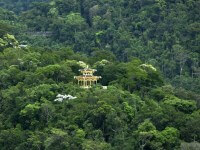 The Tijuca Forest is the largest man-made urban forest in the world. Before reforestation, the place was home to coffee farms. Today, the Tijuca National Park is home to 328 species of animals, including amphibians, birds, and mammals. Some of them are in danger of extinction.
The Tijuca Forest is the largest man-made urban forest in the world. Before reforestation, the place was home to coffee farms. Today, the Tijuca National Park is home to 328 species of animals, including amphibians, birds, and mammals. Some of them are in danger of extinction.
Learn more about the Fauna and Flora of Rio de Janeiro.
Rocinha
Rocinha is the largest favela in South America. It is home to over 100,000 people spread around 25,000 households, according to the Brazilian Institute of Geography and Statistics.
The Girl From Ipanema
Great names of Brazilian music used to meet up at Ipanema Beach in the ’60s, just like Vinicius de Moraes and Tom Jobim, who wrote ‘The Girl from Ipanema’. Helo Pinheiro, an Ipanema resident, was the inspiration for the song. She always passed by them wearing a bikini on her way to the beach. Tom and Vinicius wrote the famous song in 1962, when Helo was only 17.
Study Portuguese in Brazil and discover many other interesting facts about Rio de Janeiro while exploring the city and the language. Join Caminhos Language Centre.


 Deutsch
Deutsch Français
Français Português
Português Español
Español
